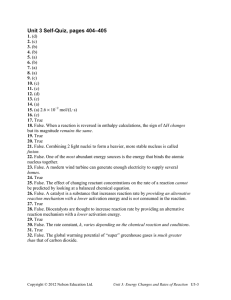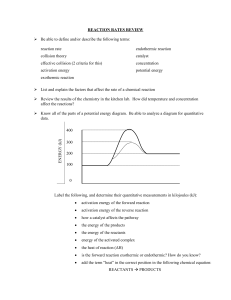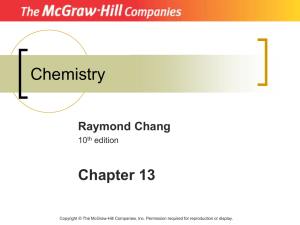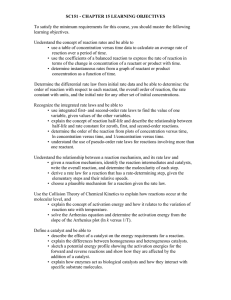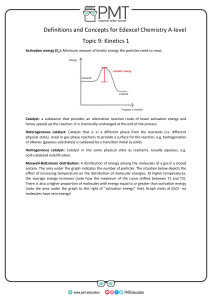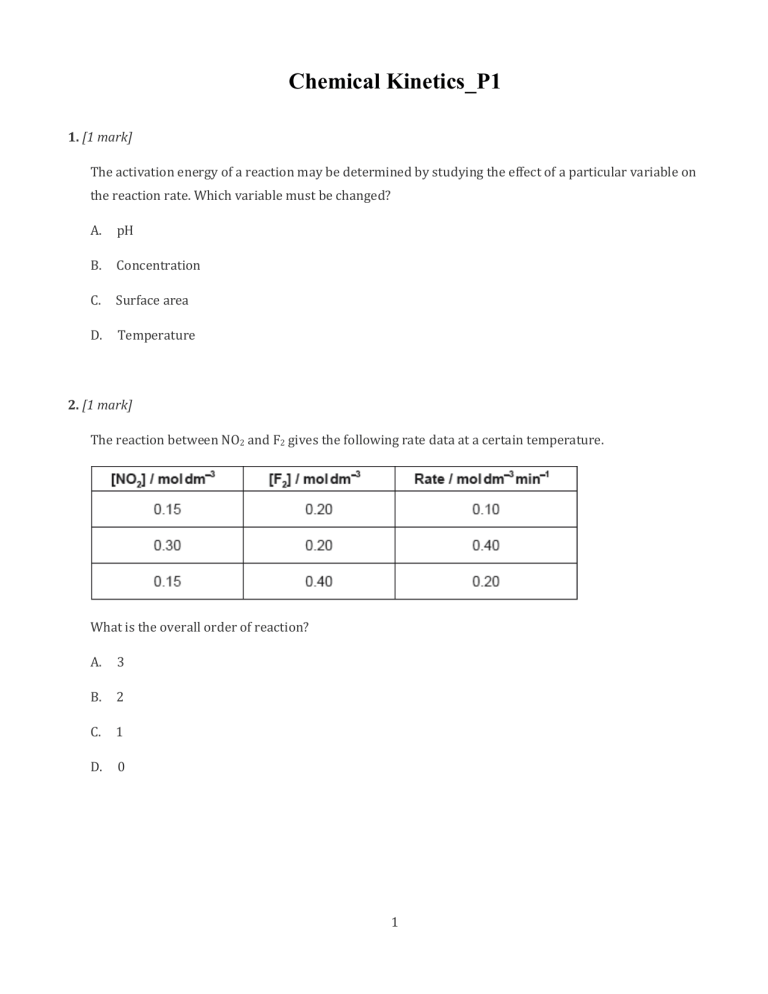
Chemical Kinetics_P1 1. [1 mark] The activation energy of a reaction may be determined by studying the effect of a particular variable on the reaction rate. Which variable must be changed? A. pH B. Concentration C. Surface area D. Temperature 2. [1 mark] The reaction between NO2 and F2 gives the following rate data at a certain temperature. What is the overall order of reaction? A. 3 B. 2 C. 1 D. 0 1 3. [1 mark] What is the effect of increasing temperature on the rate constant, k? A. The rate constant does not change. B. The rate constant decreases linearly. C. The rate constant increases exponentially. D. The rate constant increases proportionally with temperature. 4. [1 mark] When X reacts with Y to give Z, the following graph is plotted. What can be deduced from the graph? A. The concentration of X is directly proportional to time. B. The reaction is first order overall. C. The reaction is zero order with respect to X. D. The reaction is first order with respect to X. 2 5. [1 mark] Which statement is correct? A. The value of the rate constant, k, is independent of temperature and is deduced from the equilibrium constant, Kc. B. The value of the rate constant, k, is independent of temperature and the overall reaction order determines its units. C. The value of the rate constant, k, is temperature dependent and is deduced from the equilibrium constant, Kc. D. The value of the rate constant, k, is temperature dependent and the overall reaction order determines its units. 6. [1 mark] The rate expression for the reaction X (g) + 2Y (g) → 3Z (g) is rate = k[X]0 [Y]2 By which factor will the rate of reaction increase when the concentrations of X and Y are both increased by a factor of 3? A. 6 B. 9 C. 18 D. 27 3 7. Which pair of statements explains the increase in rate of reaction when the temperature is increased or a catalyst is added? 8. The table gives rate data for the reaction in a suitable solvent. C4H9Br + OH− → C4H9OH + Br− Which statement is correct? A. The rate expression is rate = k [C4H9Br] [OH− ]. B. The rate increases by a factor of 4 when the [OH− ] is doubled. C. C4H9Br is a primary halogenoalkane. D. The reaction occurs via SN1 mechanism. 4 9. [1 mark] What are the units for the rate constant, k, in the expression? A. mol2 dm−6 s−1 B. mol−1 dm3 s−1 C. mol dm−3 s−1 D. mol−2 dm6 s−1 10. [1 mark] What happens when the temperature of a reaction increases? A. The activation energy increases. B. The rate constant increases. C. The enthalpy change increases. D. The order of the reaction increases. 11. [1 mark] Which is true of an Arrhenius plot of (y-axis) against ? A. The graph goes through the origin. B. The activation energy can be determined from the gradient. C. The intercept on the x-axis is the activation energy. D. The intercept on the y-axis is the frequency factor, A. 5 Rate = k [X]2[Y] 12. [1 mark] Consider the following proposed two-step reaction mechanism at temperature T. Step 1: Slow Step 2: Fast Which statements are correct? I. II. III. The overall reaction is . Step 1 is the rate-determining step of the reaction. The rate expression for Step 1 is rate A. I and II only B. I and III only C. II and III only D. I, II and III . 13. [1 mark] For the gas phase reaction: the experimentally determined rate expression is: rate By what factor will the rate change if the concentration of A is tripled and the concentration of B is halved? A. 0.75 B. 1.5 C. 6 D. 12 6 14. [1 mark] Which graph best represents a second-order reaction? 7 15. [1 mark] Which pair of graphs represents the same order of reaction? 8 16. [1 mark] Decomposition of hydrogen peroxide in an aqueous solution proceeds as follows. 2H2O2(aq) → 2H2O(l) + O2(g) The rate expression for the reaction was found to be: rate = k [H2O2]. Which graph is consistent with the given rate expression? 17. [1 mark] Which of the terms in the Arrhenius equation takes into account the orientation of the molecules? A. A B. Ea C. R D. T 9 18. [1 mark] Carbon monoxide and nitrogen dioxide react to form carbon dioxide and nitrogen monoxide according to the following equation. The reaction occurs in a series of steps. The equation for the rate-determining step is given below. What is the rate expression for this reaction? A. rate B. rate C. rate D. rate 19. [1 mark] Consider the rate expression: Which change decreases the value of the rate constant, ? A. Increase in the reaction temperature B. Decrease in the reaction temperature C. Increase in the concentration of X and Y D. Decrease in the concentration of X and Y 10 20. [1 mark] What are the units of the rate constant for a zero-order reaction? A. s B. C. D. 21. [1 mark] The hydrolysis of tertiary bromoalkanes with a warm dilute aqueous sodium hydroxide solution proceeds by a two-step mechanism. Step I: Step II: Which description of this reaction is consistent with the above information? 11 22. [1 mark] Consider the following reaction between nitrogen monoxide and oxygen. The reaction occurs in two steps: Step 1: fast Step 2: slow What is the rate expression for this reaction? A. Rate B. Rate C. Rate D. Rate 23. [1 mark] What happens to the rate constant, k, and the activation energy, reaction is increased? 12 , as the temperature of a chemical 24. [1 mark] X and Y react according to the equation . The reaction can be described by the following mechanism: slow fast What is the order of the reaction with respect to X and Y? 13 25. [1 mark] Curve X on the graph below shows the volume of oxygen formed during the catalytic decomposition of a solution of hydrogen peroxide. Which change would produce the curve Y? A. Adding water B. Adding some 0.1 mol dm–3 hydrogen peroxide solution C. Using a different catalyst D. Lowering the temperature 14 26. [1 mark] Bromine and nitrogen(II) oxide react according to the following equation. Which rate equation is consistent with the experimental data? A. B. C. D. 27. [1 mark] Which step is the rate-determining step of a reaction? A. The step with the lowest activation energy B. The final step C. The step with the highest activation energy D. The first step 15 28. [1 mark] Which statements explain why a catalyst is used in the Contact process (shown below)? I. II. III. A catalyst lowers the activation energy. A catalyst moves the position of equilibrium towards the product. A catalyst allows the same rate to be achieved at a lower temperature. A. I and II only B. I and III only C. II and III only D. I, II and III 16 29. [1 mark] The diagram below shows the energy changes for a reaction with and without a catalyst. Which symbols represent the activation energy, , and the enthalpy change, catalyst? 17 , for the reaction with a 30. [1 mark] The following experimental rate data were obtained for a reaction carried out at temperature T. What are the orders with respect to A(g) and B(g)? 18
